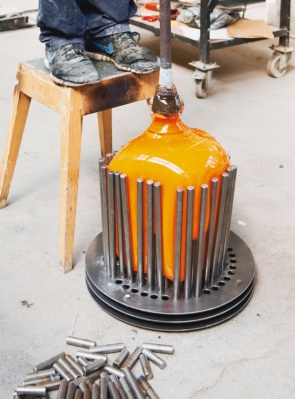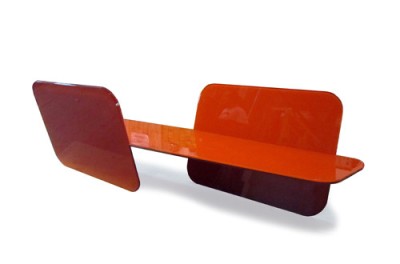 “Mould in Motion,” by ECAL/Philipp Grundhöfer, 2012. photo: ECAL/Nicolas Genta courtesy: Gallery Libby Sellers
“Mould in Motion,” by ECAL/Philipp Grundhöfer, 2012. photo: ECAL/Nicolas Genta courtesy: Gallery Libby Sellers
Among the more than 300 events and exhibitions in the 2012 London Design Festival, which came to a close on September 23rd, were two shows featuring new designs in glass. “Hot Tools,” an exhibition at Gallery Libby Sellers on view through September 29, showcases the results of a weeklong workshop for graduate design students from ECAL, the University of Art and Design Lausanne, who devised unique glassblowing tools with wood, steel rods, and other materials to execute their designs. “Bench Years,” one contribution to the festival from the Victoria and Albert Museum, featured a series of 10 benches, each created in a different medium, in the museum’s John Madejski Garden. Murano-born Luca Nichetto contributed a red glass bench designed for Established & Sons.
 A movable wooden mold was used for “Mould in Motion,” by ECAL/Philipp Grundhöfer photo: ECAL/Nicolas Genta courtesy: Gallery Libby Sellers
A movable wooden mold was used for “Mould in Motion,” by ECAL/Philipp Grundhöfer photo: ECAL/Nicolas Genta courtesy: Gallery Libby Sellers
Graduate designers from ECAL were tasked with challenging the conventions of glassmaking with the help of designer Ronan Bouroullec and glassblower Matteo Gonet. After visiting Gonet’s workshop in Basel, “students had to design and produce tools and utensils, and invent scenarios that would create an interesting effect in Matteo’s artisanal glass-making process,” explained Boroullec in a prepared statement. Some of the designers made unconventional molds to produce their pieces, including Philipp Grundhöfer’s Mould in Motion (2012), a shifting tower of brown glass imprinted with each swivel of the designer’s dynamic wooden mold.
“The new mould consists of different heights and different shaped openings on the inside,” Grundhöfer explained on the Gallery Libby Sellers website. “Each module can be turned in different directions around a pivot while the glassblower blows the still soft glass into the mould. This gives the glassblower direct control over the final shape and allows him to create unique glass pieces.”
 Rita Botelho’s mold features movable steel rods. photo: ECAL/Nicolas Genta courtesy: Gallery Libby Sellers
Rita Botelho’s mold features movable steel rods. photo: ECAL/Nicolas Genta courtesy: Gallery Libby Sellers
The range of materials used to design glassblowing tools also encompassed steel, carbon fibers, leather, glass powder, and copper. Rita Botelho used a mold of movable steel rods for DIY Mould (2012). “The mould itself is like the glassblowing process: playful and dynamic,” says Botelho on her website. Diane du Chaxel turned to carbon fibers for a soft mold to create patterns inside glass objects. Bricks produced the indentations in Stein (2012), an eye-catching piece designed by Felix Klingmüller. The process behind many of the pieces can be seen in a video from ECAL available online here.
With its two backrests opposite one another, Nichetto’s Red Glass Bench (2012), is an urban tête-à-tête sofa, a French furniture form from the mid-nineteenth century popular in parlors. “The main point of my inspiration was to create an object that would establish a connection among the people using it, a sort of small urban living room,” explains Nichetto on his website. He chose to work in glass as an homage to his birthplace, Murano, and “to show that, thanks to technology, [glass] can go beyond décor and become a structural material.”
 Luca Nichetto designed “Red Glass Bench” with the aim of creating “a sort of small urban living room.”
Luca Nichetto designed “Red Glass Bench” with the aim of creating “a sort of small urban living room.”
—Grace Duggan
IF YOU GO: “Hot Tools”
Through September 29, 2012
Gallery Libby Sellers
41-42 Berners Street
London W1T 3NB
United Kingdom
Tel: +44 (0)20 3384 8785
Website: www.libbysellers.com


